I am returning to one of my favourite places, after a gap of several years. It is where I love to go birdwatching although that is only one of its many attractions.
The tarred road we use to get there, as is the norm in Limpopo Province, is a nightmare to drive on and my brother-in-law is a study in intense concentration as he tries to navigate the countless gaping potholes. We bump along the section that runs along the southern base of the Soutspanberg, then crawl up, via Vivo, to All Days. Here we branch off right.
The fact that the journey ends up taking twice as long as it should have doesn’t dent my enthusiasm for we are headed to Mapungubwe. It is somewhere along here my grandmother also travelled, as a very young member of the Moodie Trek, on her way up to the then Southern Rhodesia. Unlike us, she travelled by ox-wagon, not in an air-conditioned Isuzu bakkie…
There is a stark minimalist, beauty to the landscape around here. The miles and miles of stunted mopani, the sudden, jagged outlines of ochre and strawberry-pink, rock outcrops and cliffs, the barrenness of the earth, all give it a slightly strange, almost mystical, atmosphere.
Returning to Mapungubwe is like a homecoming to me. Clambering out the car after the long drive, I stand, look and listen and let myself become part of the place again. Tshugulu Lodge, where we have booked in, is surrounded on all sides by towers of red, sandstone rock, eroded by the wind and rain and sun in to all sorts of weird, fantastical shapes.

We are thrilled to find we have it all to ourselves
On the first morning, I get up at 0530 and go outside with my mug of tea. My brother-in-law has, as usual, beaten me to it and is already sitting outside but my sister is still asleep in her room.
As I plop down in the chair next to him, he points to the soft, wet sand in front of us and says “We had a visitor during the night!”. I immediately see what he is talking about. The huge footpads of a solitary elephant lead from the lodge gate to the swimming pool and then head out again along a slightly different path. There has been much testimony as to the silence of elephants so I hadn’t heard a thing but my niece, Kelly, whose cottage was much closer, had listened to it siphoning up vast quantities of heavily chlorinated water.
It is a perfect African morning, a time when the world still belongs to the animals. Above us I can hear the European Bee-eaters calling as they soar and glide in the thermals. When the breeze blows I catch the smell of Wildebeest, grazing not far from the perimeter fence of the lodge. Somewhere in the unseen distance I can imagine carnivores finishing a kill before heading off to lie in the shade,
The rock cliffs, that hem us in like an old-fashioned castle wall, glow orange-red from the rays of the early morning sun. As I do a quick scan through my binoculars I see a snapshot of birds and other small creatures. Amongst the cracks and crevasses, the resident gang of Red-winged Starlings play hide-and-seek. In the shade of a Large-leafed Rock Fig which has sent its ghost-white roots burrowing down through the cracks and fissures, I hear the soft hooting of a Laughing Dove. Near it a skink, with brown stripes along its back, raises its head out of the rocks as if to smell for rain.
Down on the ground, not far from where we are sitting, a pair of Natal Francolin scurry past on some unknown errand. In the tree above us the beautiful Red-headed Weavers sway and dangle before flying off to bring back beak-load after beak-load of carefully selected twigs with which they construct their nests. Their pain-staking industry is more than matched by all the activity in the Lala Palm where a small colony of Lesser-masked Weavers have opted to build. They prefer to use grass and palm shards.
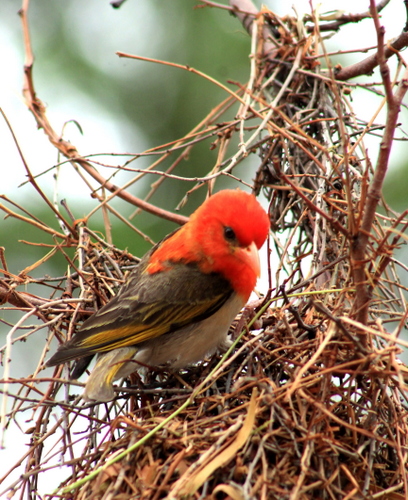
Red-headed Weaver 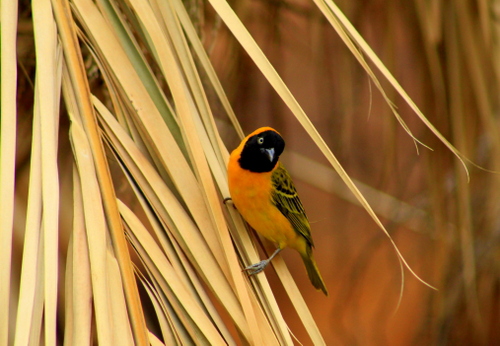
Lesser Masked Weaver
After a breakfast of fruit, muesli and yoghurt, we head off to the Eastern Section of Park. This arid area occupies a unique position in the country’s history for it was here that South Africa’s first important kingdom was established between 1200 and 1290 AD. Ruins left behind by Africa’s early civilizations are almost invariably found in hill country (Great Zimbabwe and Thulamela in Kruger are other obvious examples) and the Mapungubwe Hill site is no exception. From the summit of this steep-sided bute, its rulers would have been in a good position to keep an eye out out for enemy warriors, as well as greet traders coming up the Limpopo – for it is known they kept extensive links with the east, including the Chinese and Indians, the sails of whose ships were swept over to Africa on the winds of the monsoons.
We do not have time to visit the hill that marked the centre of their civilisation but from the top of the lookout site, at the confluence of the Limpopo and Shashe Rivers (where the borders of Zimbabwe, Botswana and South Africa meet), we can just make out its red ramparts rising out of the dusty earth. From here, the road, ostensibly for 4×4 usage only, takes us along the Limpopo River as far as Poacher’s Corner before branching off through yet more oddly-shaped hills and balancing rocks.
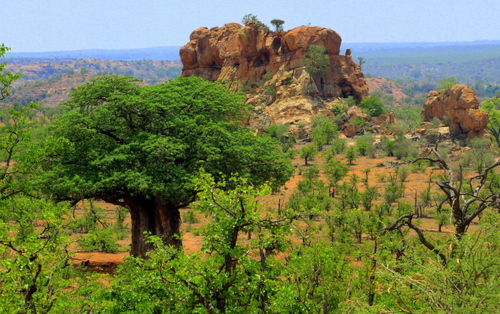
We return to the lodge, later that day, to find the local squirrel has taken advantage of our absence and made merry in the kitchen. Rusks have been chewed on, a bottle of honey lies open, its contents spewed all over the table and floor…
That evening, deciding to take advantage of the balmy summer light, we climb up one of the kopjes behind the lodge for sundowners. The view is astonishing. To our north, on the other side of the Limpopo, a massive storm is brewing. Soaring thunder heads rise above the plains casting the world beneath it in an unholy purplish light. There are bolts of jagged lightning, followed by the drum-like roll of thunder. You can feel the malevolence in the heavy air and smell the rain although it never actually reaches us.
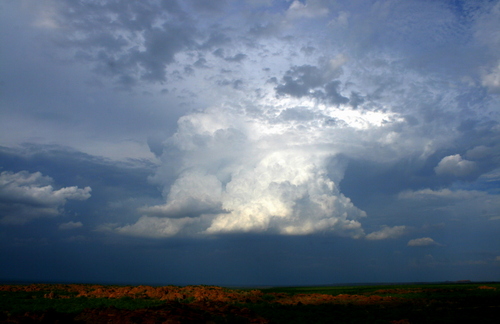
There seems to be no limit to our vision. One our right side, a labyrinth of glowing, sun-burnished, bare rock, pock-marked and twisted and looking like it could be guarding the entrance to the underworld, stretches away from us. Somewhere, in the ultimate distance, land and sky merge. It feels like we have the universe all to ourself.
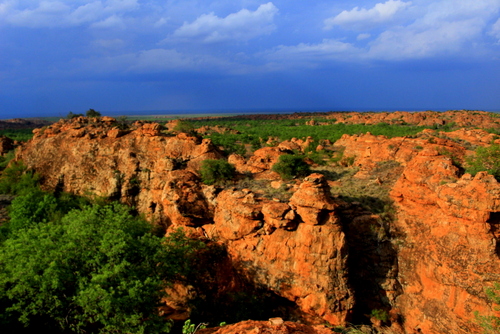
Anxious to transcript so great a mystery, I pull my camera out of its bag and start snapping. Then I just sit still for a long time watching the unfolding drama until eventually the fading light sweeps it all away…
That night I lie content beneath my mosquito net as the air conditioner – a novelty for me since I mostly camp on these adventures – drones away. Outside the crickets call.
I rise even earlier, the next morning, but it does no good. My brother-law-law has beaten me to the kettle again. He tells me we have had more visitors. These ones are much smaller than the formidable old behemoth who visited us the previous night. In the magic of twilight they had come flying out from their hidey-holes and roosting nooks.
They are bats.
Bats have always received a bad rap. Some time, back in history, perhaps around the period the when the church started persecuting perceived witches, they were turned in to creatures of ill-omen, along with crows, owls and – oddly enough – hares (it was thought that witches could shape-shift in to them). Later they came to be associated with vampires and Count Dracula and sharpened stakes and bundles of garlic. It is a label and an association they manifestly do not deserve for these nocturnal wanderers are marvels of evolutionary engineering..
I don’t know much about bats but my brother-in-law does. An Emeritus Professor, he is an expert on the subject. The reason he knows they have been active while we slept is because – like some Cold War spy – he has been secretly recording their chatter on two metal Bat Detectors he has attached to some trees. I listen raptly as he explains their workings. Because they mostly fly around at night bats can be difficult to identify but science – and technology – has found a way around that by tuning in to the ultrasonic sounds the bats emit.
My brother-in-law’s findings from this and subsequent recordings are, to my mind anyway, amazing, revealing a secret night-time world in which the bats are completely at home (see Acknowledgement below).
The bat puzzle solved, we next set out to explore our corner of the park, a lot of which is new to me.
The day is hot but bearable because the heat is mostly dry. Our route takes us through a badlands of arid hills and trees that are, for the most part, low and barren. In marked contrast, every now and again, we come across a baobab rising like some ancient monument, sometimes in the middle of nowhere, some times next to the stone face of a kopje.
This is good raptor country. In no time I have added Martial Eagle, Black Eagle, African Hawk Eagle, White-backed Vulture, Common Buzzard, Brown Snake-Eagle and Gabar Goshawk (black form) to my bird list. Plus a Kori Bustard and a Red-crested Korhaan. Later, we will see the male Korhaan performing its strange courtship ritual, flying straight up in to the air and then closing its wings and tumbling to the ground, as if shot, before gliding in to land.
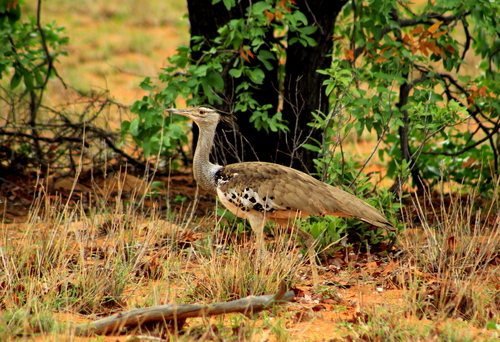
After taking us through more rough, broken, terrain, the road starts winding down in to a rock-strewn valley which, in turn, opens up on to an immense plain, on the one edge of which lies the Limpopo. As you approach the river, the Mopani scrub abruptly gives way to a green line of tall trees – Nyala Berry, Jackal Berry, Natal Mahogany, Ana Trees, Apple Leaf.
I am a little taken back by the state of the Mazhou camp site which has altered much since I stayed there last. The electric fence that protects it no longer seems functional and everywhere there are scenes of devastation. I know who the culprits are. As in Kruger, elephant are presently destroying the acacia thorn (and many other species of tree) that also grow along the river bank at a rate regeneration can’t keep pace with. Those not knocked down have been stripped of their bark and are dying that way. In ten-years time I doubt if there will be many of these beautiful trees left to see.
One can only hope this is part of nature’s cycle although I am not convinced. In former times, elephants herds were scattered and nomadic which helped minimise the damage they cause; now their movements have been confined to restricted habitats, such as the one we are driving through. The results of this loss of freedom to wander at will are plain to see…
From the camp site we follow the river for a short distance, through the tall trees that provide favourite perches (and nests) for the vultures, before branching off to the Maloutswa Pan Hide.
As the main rains have still not arrived there is not much water in the pan. The mud that occupies the place where liquid should be is black and cracked and caked and pitted like the moon’s surface. Numerous hoof-marked tracks lead down through it.
Obviously fans of the formula that there is safety in numbers, we find an immense gathering of baboon squatting by the water side. It is the biggest troop I have ever seen. As we sit watching them, another, even larger, troop suddenly emerges out of the tree line.
As they draw closer to one another, I can scarcely believe my eyes or my ears. It is like a clash between two medieval armies. There is an immediate outbreak of barking and a hurling of wild manic howlings. This is followed by lots of jumping up and down, chest-thumping and angry gesticulating. The baboons are doing it, I soon realise, only for dramatic effect. It is a mock call-to-arms and does not signal the start of an all-out war.
Realising they are outnumbered, the troop already at the waterhole stages a strategic withdrawal, yelling parting taunts and trying desperately to preserve their dignity and not show any loss of face. They retreat to a position a hundred metres or so downstream where they sit down and mutter conspiratorially amongst themselves. For our part, we find it a rather an impressive performance and feel like clapping but the solitary, bored-looking, Spurwing Goose who was in the middle of the battlefield remains completely unmoved. He has obviously seen and heard it all countless times before…
On the way back from the pan my sister sees two Crowned Lapwing in an open patch of ground and then, a bit further down the road, says “Look – two more of them under that tree!”. Although, I am on the wrong side of the car to see them, a little bell goes off in my head. Maybe they are not plovers at all! I urge my brother-in-lay to stop and reverse back to them. I am very glad I do for it turns out to be a pair of Triple-banded Coursers which are extremely unusual in South Africa. I am even more amazed when I see they have two chicks. In Africa, all game birds suffer high rates of nesting loss. There open homes are highly vulnerable to a whole host of predators – caracal, serval, jackal, civet cat, genet cat mongoose, raptors, various egg-eating snakes.
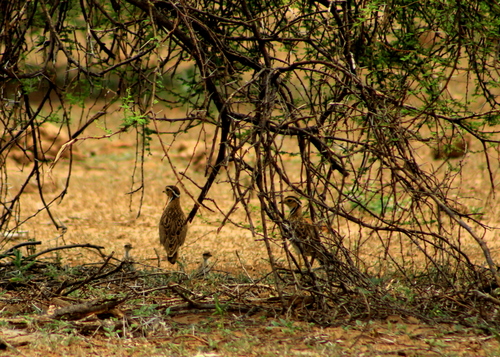
The chicks are lucky to have survived so far.
Returning home we take a slight detour to Little Muck which lies on a ridge below which a seasonal stream bed runs. How it got its odd name I have not been able to ascertain but it is a good place to see elephant. There are also several San rock-painting sites in the area but I imagine you have to get permission to see them. There are more baobab standing here in heraldic silence, their branches covered in the sprawling nests of the Red-billed Sparrow Weaver. With the exception of those in more inaccessible positions, they too, have been badly gored, stripped and desecrated by the elephant. I suspect many of these ancient, symbolic trees won’t survive either.
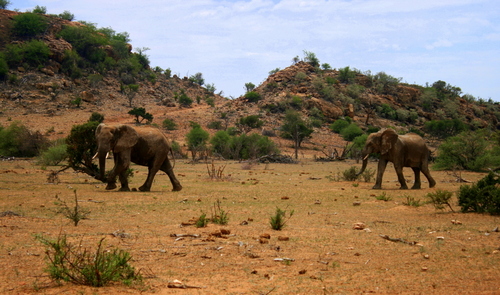
Elephant near Little Muck 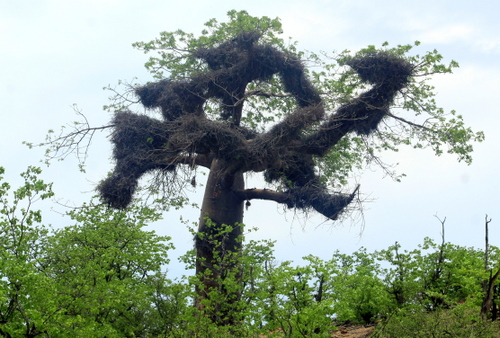
Red-billed Sparrow Weaver nests in baobab
Which would be sad because, standing under them, I felt overwhelmed by the age and might of this old continent and realised – yet again – what an important part of it they are…
GALLERY:
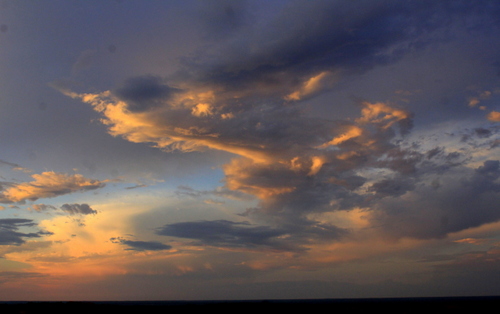
Clouds over Mapungubwe 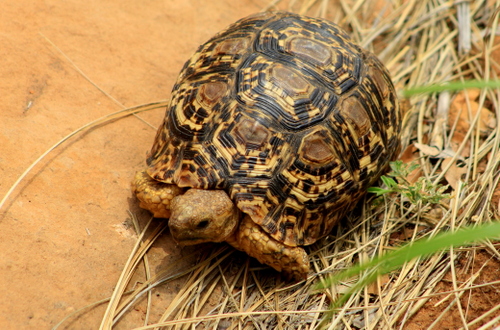
Leopard Tortoise 
Rock looking like a train 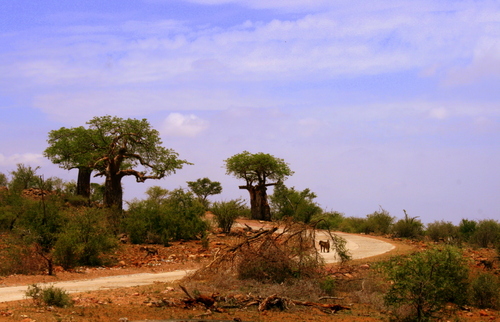
Baobabs with baboon 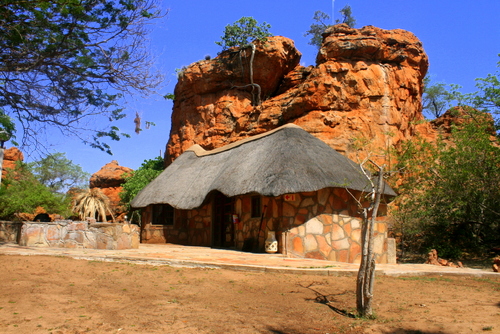
Tshugulu Lodge 
Kopje near Tshugulu Lodge 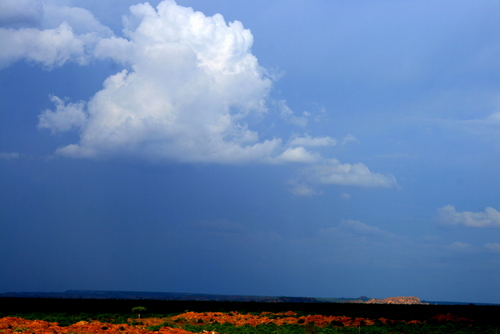
Storm clouds over Limpopo 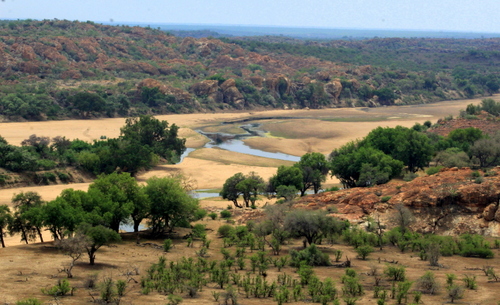
The Limpopo River 
Dassie (Rock Hyrax) 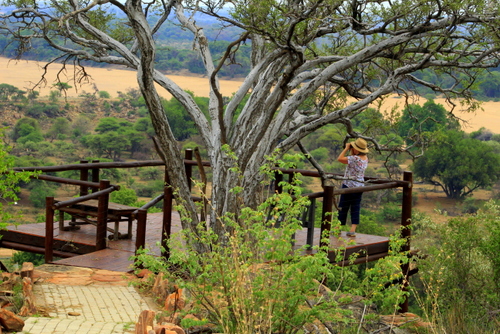
View point. 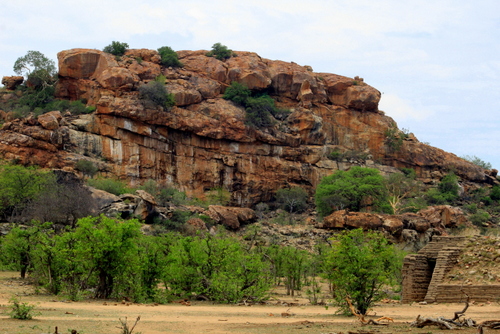
Old SANDF bunker
ACKNOWLEDGEMENT
I am extremely grateful to my brother-in-law, Emeritus Professor Ric Bernard, for organising this trip and for his many kindnesses, information and assistance. To help me understand the world of bats better he also kindly prepared the following notes:
Studying bats is not easy because they are active at night and spend the days in often inaccessible places. They are hard to see in flight at night and almost impossible to identify even when they are seen. However, in the same way that birds can be identified based on their calls, so too can bats – with the same proviso that identification based on call alone is not always accurate. However, unlike birds where the call can be heard, the calls of bats are at a frequency that is far too high to be heard by us. This makes studying bats very different from studying birds. The ultrasonic calls of bats can be detected and recorded and on a recent trip to Mapungubwe and Mopani we used two Song Meter bat detectors to record the bats in the area. Over 6 nights, we recorded more than 16000 bat calls. Analysing these calls manually would be very time consuming and we used software to do this and to group calls into clusters. We were then able to examine the clusters and based on previous work to identify most of the calls.
The ultrasonic calls of bats are used to detect their prey and their surroundings (echolocation) and typically not to communicate with other bats. The call of each species is characterised by a particular frequency or range of frequencies and it is based on this that they can be identified. Calls fall into one of three groups, being Constant frequency (CF) where the call is relatively long and at a single frequency, Quasi Constant frequency (QCF) where the call is long and covers a very small range of frequencies, and Frequency Modulated (FM) where the call is shaped like a hockey stick and covers a range of frequencies from high to low at the bend of the hockey stick.
The CF bats are all horseshoe bats and we recorded six different constant frequency calls at 35, 47, 76, 81, 105 and 114 KHz (kilohertz). The likely species were the cape horseshoe bat, Geoffroy’s horseshoe bat, Darling’s horseshoe bat, Hildebrandt’s horseshoe bat, Lander’s horseshoe bat, Swinny’s horseshoe bat.
Amongst the FM bats, we identified the Cape serotine, long tailed serotine, banana bat, rusty pipistrelle, Natal long fingered bat, and Temminck’s myotis.
The vast majority of the recorded calls came from the QCF group. These are bats that often inhabit the roofs of houses and which SANParks are trying to attract into bat houses that we saw at both Mapungubwe and Mopani. The species included Midas free tailed bat, Angolan free tailed bat, Egyptian free tailed bat, Mauritian tomb bat, large eared giant mastiff bat and the little free tailed bat.
All of these bats fall within their known distribution ranges.
All the species are insectivores and will be feeding on both flying and sedentary insects.
I would also like to thank my sister, Penny, for the wonderful food and – along with her daughter, Kelly – being such good company.

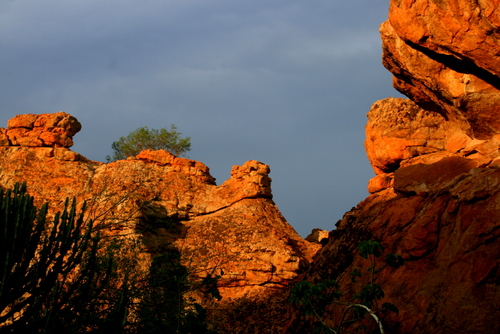
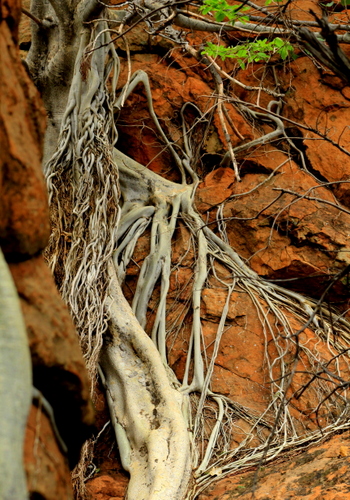

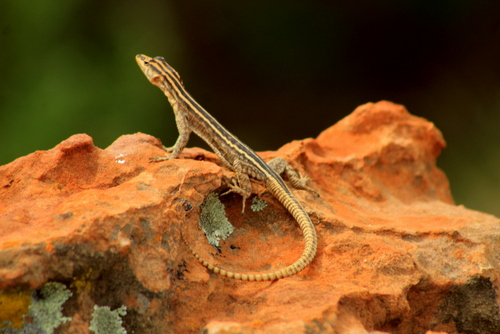
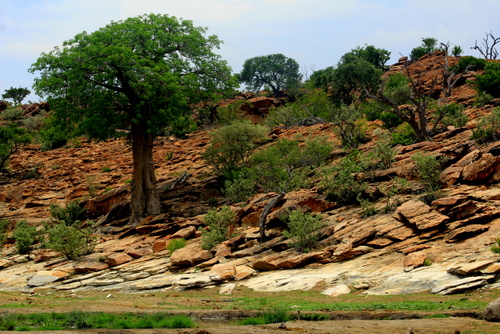
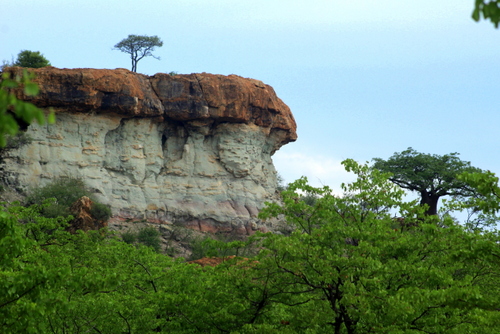
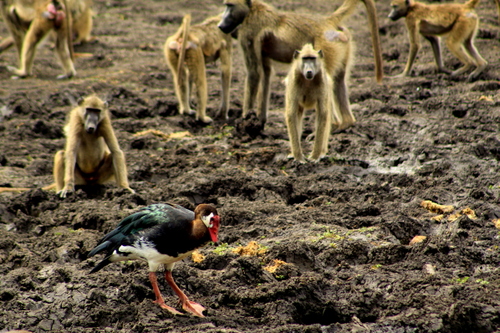
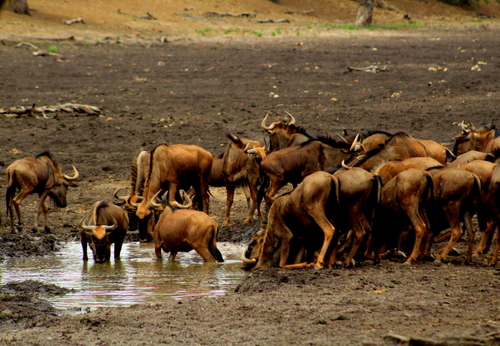
A good read and very interesting. Thank you Stidy and Ric
LikeLike
Thanks so much, Greame. So glad you enjoyed it!
LikeLike
After this story a visit is on.
So well written and informative
LikeLike
So pleased to hear I have inspired you, Hugh. I don’t think you will be disapointed.
LikeLike
Wonderful Stidy! What a lovely, fascinating description of such a special place. Great photos too. Thank you!
LikeLike
Thanks, Ken. I look forward to visiting it again one day with you…
LikeLike